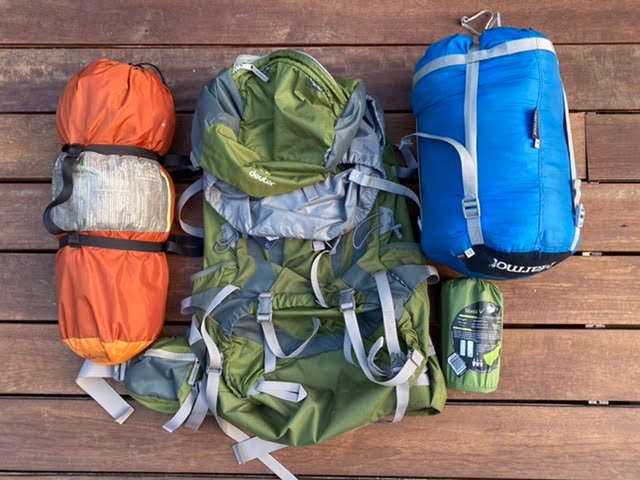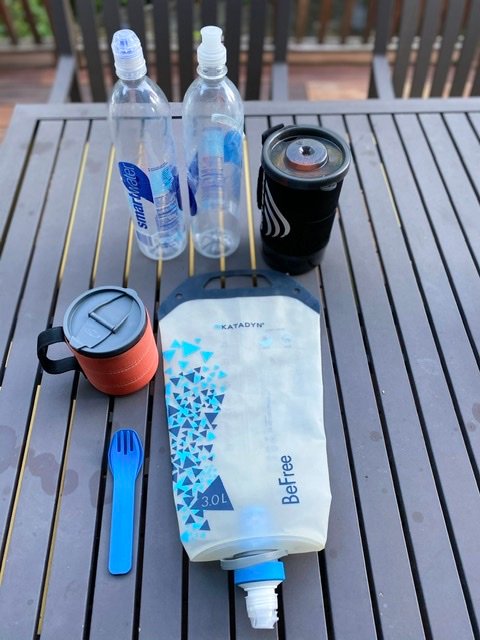The Big 3 usually refers to the heaviest three items: shelter, backpack, and sleep system. This is an introduction to the basic Big 3 needed for backpacking.
Tent
For your first trip shelter will usually be a tent. Generally, tents can weigh anywhere between 2 and 5lbs. If you are backpacking alone you’ll want a 1 or two-person tent (tents generally measure on the small side) and if you are planning on going with a partner then a 2 or 3 person tent. There are some rock-solid tents that are reasonably priced.
For example, REI has a Half Dome 2 Plus, which although a little heavy for a single person, is a solid tent. This is the first tent I used for backpacking and is still going strong after 15 years. (You can see my evolution of tents here). I now primarily use this tent to lend to people. So if you have friends into backpacking they are likely to have a tent they can lend you (we are all gear junkies at heart). For a first-time outing, this would be my recommendation – see if you can borrow a tent.
Backpack
The second major item is the backpack. This one is possibly the most critical. A badly fitting backpack will make the entire experience excruciating. This often makes borrowing a backpack a little more difficult. There are several factors to take into consideration for backpacks, size is one. Generally, size is measured in liters and you’ll want something between 50 and 70l. This is the internal volume. Generally, if you get a bigger backpack then you’ll find stuff to fill it with! As you get more experienced you will likely move towards smaller backpacks and lighter overall weights.
My current backpack is an REI Flash 55, but Osprey, Deuter are all good brands. This is one area I’d definitely recommend going to the store and getting one fitted. After size the next common question is whether you want a pack that can have a hydration pack – this is where there is a bladder in the pack and you can drink the water as you hike. Although this seems very convenient, I’ve moved away from this as the bladder often feels like it gets in the way of packing the backpack and they are a pain to refill on long hikes.
They are likely to ask you whether you want a pack cover – it’s essential that you keep the content of your pack dry. There are two basic strategies to this. One is a pack cover that goes over the outside of the pack and tries to keep the rain out – the other is to line your pack with a trash compactor bag and keep the content inside the bag dry. Your pick!
Sleep System
Now you have a tent and pack you need a sleep system – this comprises of a sleeping bag, pad, and pillow. We can assume as this is your first trip, you are going to be doing this in summer-like weather and you’ve checked the weather so it will be a reasonably warm night. In this case, a 30-degree bag will be sufficient – The rating on the sleeping bag is not so much a comfort rating as a ‘you’ll survive’ rating – so don’t plan on taking a 30degree bag out in near-freezing weather. Indeed if you live in a warmer climate you can even get away with a sleeping bag liner, but that might depend if you are a warm or cold sleeper.
Sleeping bags come in various shapes (mummy, rectangle) and filling types (synthetic, down). Down is generally warmer and compresses better – but is also more expensive and is a very poor performer if it gets wet. Sleeping bags can get pretty heavy and bulky. My first backpacking sleeping bag was a Marmot Trestles 15 that weighed almost 4lbs.
A sleeping pad goes between you and the ground. This provides both a degree of comfort and insulation – however it’s not going to be like the 8-inch pillow top mattress you have at home. The Klymit Static V is good value as a starting pad (I have used this for a few years), there is also an insulated version (which is slightly heavier) the Klymit Insulated Static V. These are both good value! Finally, you’ll need a pillow. Some folks will just stuff clothes into their sleeping bag stuff sack. This never worked very well for me but might be ok for a first time. Having said that it took me years to finally find a pillow that worked for me. I ended up with the Trekology pillow that works well.
What’s changed over time
The big 3 will account for the bulk of the weight and cost. You may initially have around 10lbs Or more in weight – but to reduce the weight you’ll spend more money. My big 3 currently weigh just about 7lbs. That saving can make a significant difference to the overall hiking experiences, particularly if you are an older hiker.
| REI Half Dome 2+ | 5lb 12oz |
| Deuter 65+10 | 4lb 3oz |
| Marmot Trestles 15 | 3lb 14oz |
| Klymit Static V | 1lb 2oz |
My basic Big 3 when I started backpacking was. The total weight was 14lb 5oz.

| Big Agnes Tiger Wall 2 | 2lb 3oz |
| REI Flash 55 | 2lb 10oz |
| REI Magma 30 Quilt | 1lb 4oz |
| Therm-a-rest NeoAir | 16oz |
This is my current big 3. Total weight 7lb 10oz

Note that some of the links above do not link to the exact product as some of my original gear is no longer produced. In those instances I’ve linked to the closest products – in some cases, they will have different weights.
So in the evolution of my backpacking, I’ve saved over 7 pounds in just my Big 3. This is a huge benefit – that I don’t have to carry. Indeed there’s no loss in comfort – just an investment. It’s really hard to advise anyone to jump into the lightweight gear at the extra cost until you are confident this is a pass time for you.
The backpacking Big 3 is just a portion of the gear you’ll need for backpacking. Here’s a complete introduction to the gear you’ll need.





